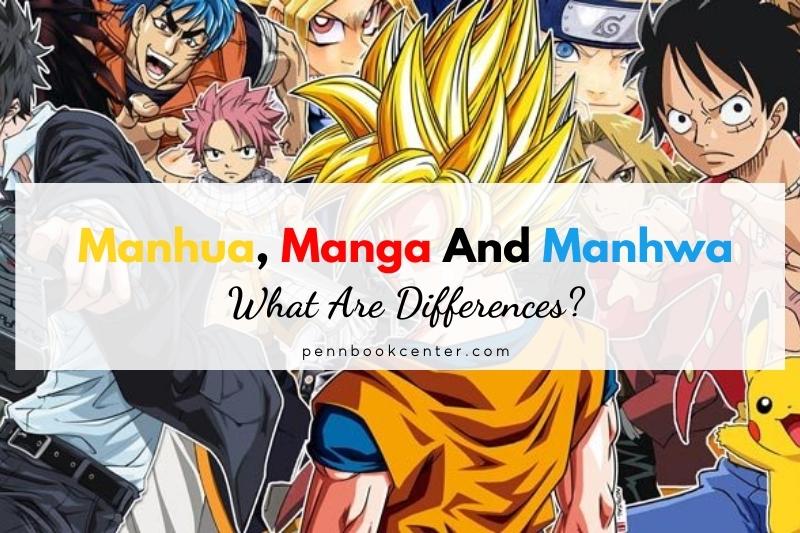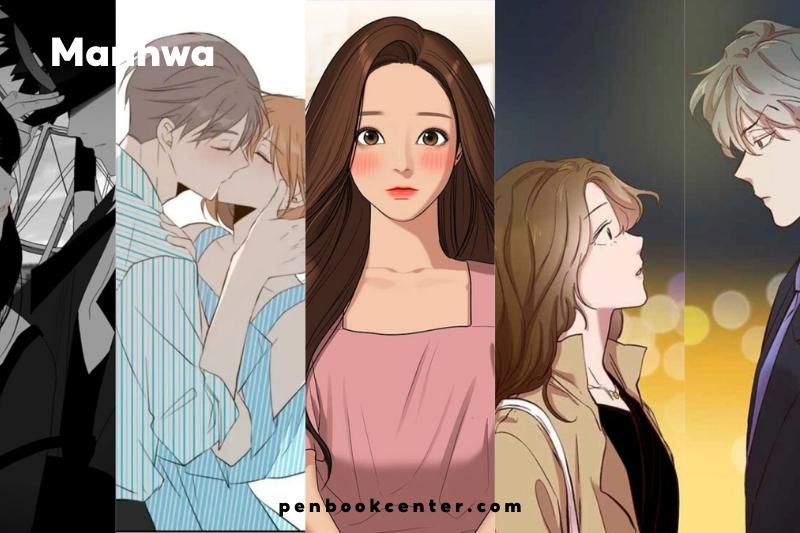- MatthewDusQues
Manhwa is a Korean comic book, while manga is a Japanese comic book. Both are known for their vibrant painting styles and fast-paced narratives. While manhua, manga, and manhwa have certain similarities, they also have some significant distinctions.
The distinction between manhua, manga and manhwa has gotten more blurred in recent years. So, what exactly is the difference between the two? If you’re a lover of manhua, manga or manhwa, it’s essential to understand the differences! Here are some of the fundamental differences between manhua, manga and manhwa.
Etymology Of Manhua, Manga And Manhwa
Historiographers and critics date manga, which means “comic” in Japanese, to the 18th century. Japan’s late 19th-century comic book series has gone worldwide.
Chinese manhua means “impromptu pictures.” Chinese manhua comics have a distinct style.
Korean manhwa means “comic” or “cartoon.” Korean manhwa comics include vibrant artwork and stylish storyline.
Manhua
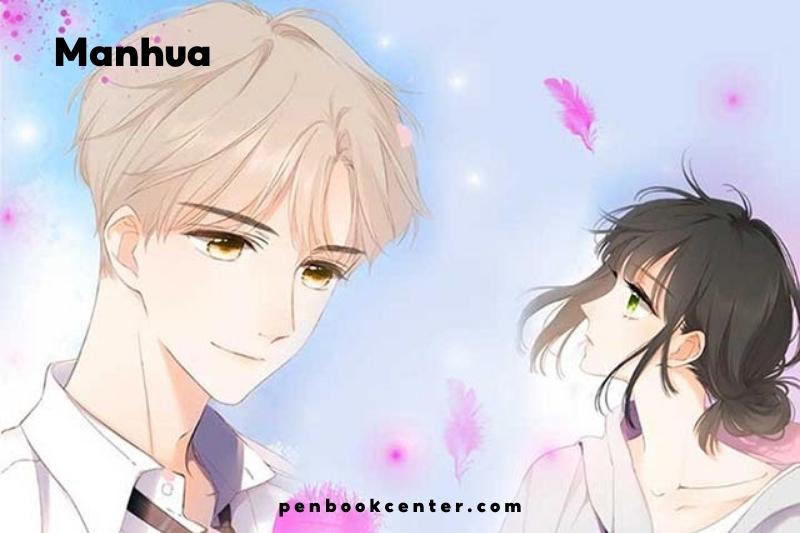
All Chinese comics are manhua. Manhua, frequently called comics in the West, is more serious and geared towards older audiences than manga.
Late 19th-century Qing era manhua was the first. Early manhua were political cartoons that satirized contemporary events. The government prohibited early manhuas, which made them more popular.
Many painters experimented with manhua throughout the 1920s and 1930s. Feng Zikai is well known for developing the lianhuanhua style of manhua, which is still popular today.
The Communist Revolution banned manhua because the new government frowned on bourgeois and decadent culture. In the 1980s, new artists experimented with manhua, bringing it back.
Manhua is more popular than ever, with many forms and genres. There’s a manhua for everyone, from thrilling escapades to deep dramas.
What Makes a Manhua Special?
Manhua comics and graphic novels can be read left-to-right or right-to-left. Hong Kong and Taiwanese manhua are read right to left, while mainland Chinese are read left to right.
Manhuajias make manhua. They depict characters more realistically than Japanese manhwagas, like Korean ones.
Computerized Manhua comics are generally printed in color. Yi Ren Zhi Xia and Soul Buster have modernized manhua animation.
Manhua comics and graphic novels are gaining popularity worldwide.
Manhua, unlike manga and manhwa, mostly covers politics, humor, action, and children, thus it’s unclear if it can match manga’s popularity.
East Asian exports end with manhua, Chinese, Taiwanese, or Hong Kong-made comics.
The first manhua, Current Affairs Comics (1904), commented on war and politics. This new art genre developed over the next two decades. In 1928, Shanghai Sketch became the first manhua publication.
The magazine created a small but thriving manhua scene in mainland China and Hong Kong. Cartoons World, another popular newspaper, appeared in the mid-1950s. This introduced new fans to manhua and solidified its place in Chinese society.
Like Korea’s manhwa, manhua has been censored and controlled by the government, and many satirical or provocative cartoons have been restricted and removed since the internet’s debut.
Manga
“Comic book” is manga in Japanese. Tankōbon volumes collect manga chapters from weekly or monthly anthology magazines. Manga stories are among the most popular in Japanese literature since the first manga magazine was released in 1775.
Manga storylines might be action-adventure, romance, or intended at young boys, girls, or middle-aged adults. Manga artists usually work in pairs, with one artist drawing and the other writing.
Manga was first popularized outside of Japan in the 1950s. American manga lovers have grown since the 1980s.
What Makes Manga So Special?
Manga influences these comics and graphic novels. However, there are crucial distinctions.
Manhwa is read left to right like English comics and graphic novels. Western viewers familiar with the genre find it easier. If you read manga, consider it.
Several popular manhwa series have been translated into other languages.
Manhwa remains popular outside Asia. Even though the worldwide fan base is growing, English-language books are scarce compared to manga.
Manhwaga artists use a different style than most comics. Characters’ large, funny eyes are more genuine and less stylized.
Manhwa is usually published as a webtoon in full color, unlike manga.
Manga’s Ascension
Manga boosts Japan’s economy. Over the past three decades, first in the US and Canada, then in Europe, its popularity has surged. Readers are worldwide today.
Manga outsells all other comics and graphic novels in the US and worldwide.
Manga is such a big industry in Japan that aspiring artists and writers study nationwide to become the greatest.
Manga creators also work in anime, another popular Japanese creative genre. Most anime, including Fullmetal Alchemist and Demon Slayer Mugen, is based on manga.
Genres of Manga
There are hundreds of genres in the manga world, so there is something for everyone, regardless of their age or hobbies.
Because there are far too many to discuss in one piece, a few of the most popular.
- Shônen
Shônen manga is geared toward teenage males. Still, due to a recent change in ideas about conventional gender norms, many young girls are now reading shônen. Despite this, the primary character is usually invariably a man.
Shônen is known for its high-octane action sequences and epic adventures, which often include mild horror and violence aspects.
- Shôjo
The bulk of Shôjo manga readers are adolescent females, which makes sense given that the genre’s name is derived from a Japanese phrase, young lady.
Shôjo is more about emotional difficulties and relationships between friends and couples than action and adventure.
The artwork is idealized, with lots of bright, feminine symbols like hearts and flowers used to convey the people’s emotions in the story.
- Seinen
The name seinen means youth, yet unlike Shônen and Shôjo, this is a considerably more adult-oriented genre. Males between the ages of 18 and 30 are the most common readers. At the same time, certain seinen periodicals also have a following of businesspeople in their 40s and beyond.
The seinen genre covers various topics, from science fiction to erotica. Unlike the more basic high-action shonen manga, the tales frequently deal with grittier subjects and emphasize character and plot development.
- Josei
Josei manga is a more mature variant of shôjo manga. While it still has friends and romantic themes and emphasizes feeling over action, the artwork is less idealized. The characters are more complicated, and the story incorporates more adult and tough issues.
- Shoujo-ai and Shounen-ai
Sometimes known as yuri and yaoi, these two genres center on LGBTQ+ relationships. While some tales are exclusively romantic, many others are jam-packed with action and adventure, horror and violence, and everything.
Manhwa
Manhwa is a Korean word that refers to comics or print cartoons. In the West, the term manhwa is generally used to refer to South Korean comics, while in North Korea, it refers to comics produced in North Korea.
Manhwa has been around since the early 1900s, but it wasn’t until the 1950s that it really began to take off in popularity. The first manhwa magazine was published in 1957, and since then, manhwa has become a staple of Korean pop culture.
There are all sorts of manhwa out there, from action-packed adventures to heartwarming slice-of-life stories. No matter what your interests are, there’s bound to be a manhwa out there for you.
One of the things that makes manhwa so special is the fact that it’s such a diverse medium. There are manhwa for all ages, from young children to adults, and all sorts of genres to choose from. Whether you’re looking for something funny, touching, or just plain weird, you’re sure to find it in the world of manhwa.
If you’re interested in giving manhwa a try, there are plenty of great titles out there to choose from. Some of our personal favorites include “The Girl From the Other Side,” “White Dragon,” and “Yeonmi-go.” Whatever you end up reading, we guarantee you’ll be hooked on manhwa in no time!
What Makes a Manhwa Special?
Many of the elements of these comics and graphic novels are similar to Japanese manga. Still, there are some important distinctions as well.
One of the most striking differences is that manhwa is read from left to right like English-language comics and graphic novels. This makes it simpler for Western viewers who are more familiar with the genre. Still, it’s something to think about if you’re already a manga reader.
Although all original manhwa are published in Korean, several of the most popular series have also been translated into other languages.
Manhwa, on the other hand, is still popular outside of Asia. And, even though the worldwide fan base is expanding by the day, there aren’t nearly as many English-language books available as there are in the manga industry.
Manhwa artists are referred to as manhwaga, and their artistic style differs significantly from most comics. Characters still have huge, comical eyes, but they’re more realistic and less stylised than before.
Another significant distinction is that, unlike manga, manhwa is often made in full color, particularly when it is published online as a webtoon (which is more often than not).
What Are Webtoons?
Although some people use the phrases webtoons and manhwa interchangeably, they are not synonymous.
A webtoon is a full-color manhwa that is only accessible online. Webtoons are the most popular kind of manhwa nowadays, and most classic in-print manhwa is only available to dedicated collectors.
Difference Between Manga And Manhwa, Manhua
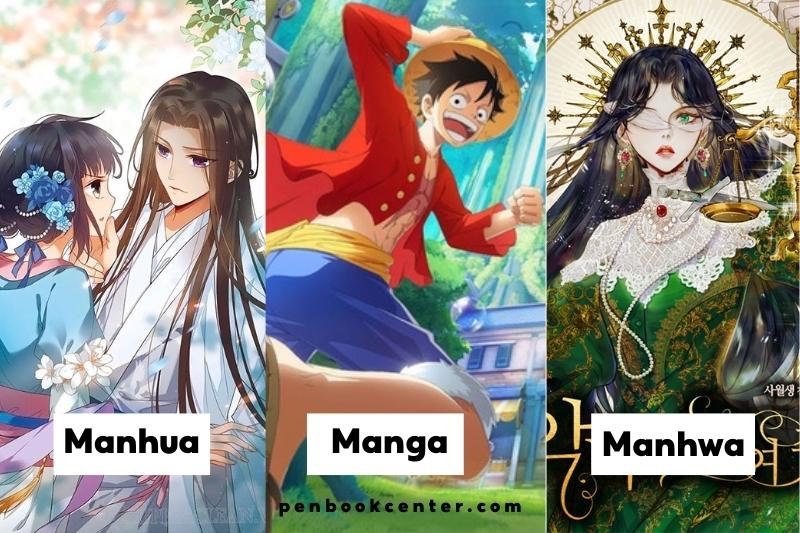
The History of Manhua, Manhwa and Manga
Manga and manhwa stem from the Chinese word manhua, meaning impromptu sketches. Japan, Korea, and China formerly used these words for all comics and graphic novels, regardless of origin.
International readers call Japanese, Korean, and Chinese comics manga, manhwa, and manhua.
East Asian comics creators are called mangakas, manhwagas, and manhuajias. Besides etymology, each country’s comics have inspired each other.
Astro Boy creator Tezuka Osamu, the Godfather of Manga, popularized manga in mid-20th century Japan. The Chōjū-Giga (Scrolls of Frolicking Animals), a collection of animal drawings by several artists, is thought to have originated manga around the 12th or 13th century.
Mangakas were influenced by European and American comics supplied by American soldiers during the American Occupation (1945–1952). Manga was popular in the 1950s and 1960s due to increased readership. Manga gained international popularity in the late 1980s.
Manhwa developed separately. Japanese soldiers introduced comics to Korea during the 1910-1945 Japanese Occupation. Manhwa was employed for war propaganda and political indoctrination from the 1930s to the 1950s.
Manhwa became popular during the 1950s to 1960s but declined due to the strict censorship laws in the mid-1960s. However, manhwa became popular again when South Korea launched websites that publish digital manhwa known as webtoons, such as Daum Webtoon in 2003 and Naver Webtoon in 2004. Then in 2014, Naver Webtoon launched globally as LINE Webtoon.
Manhua are comics from China, Taiwan, and Hong Kong. Manhua is said to have started in the early 20th century by introducing the lithographic printing process. Some manhua were politically-driven with stories about the Second Sino-Japanese War and the Japanese Occupation of Hong Kong.
Yet, after the Chinese Revolution in 1949, there were strict censorship laws, resulting in manhua having a difficult time being legally published overseas. However, manhuajia began self-publishing their work on social media and webcomic platforms like QQ Comic and Vcomic.
The Ideal Readers
There are all sorts of people who read manga, manhwa, and manhua, but there are certain qualities that make up the ideal reader. They’re passionate about the stories and characters, and they’re always on the lookout for new and exciting titles to read. They’re also willing to give anything a chance, even if it’s outside of their usual genre.
The ideal reader is also open-minded and tolerant of different cultures. After all, manga, manhwa, and manhua come from all over the world, and the best stories are the ones that transport you to another place. The ideal reader is also patient because some of the best manga, manhwa, and manhua are slow-burners that take their time to unfold.
Last but not least, the ideal reader is someone who is always eager to discuss and share their love of manga, manhwa, and manhua with others. Whether it’s online or in person, they’re always up for talking about the latest release or their all-time favorite series.
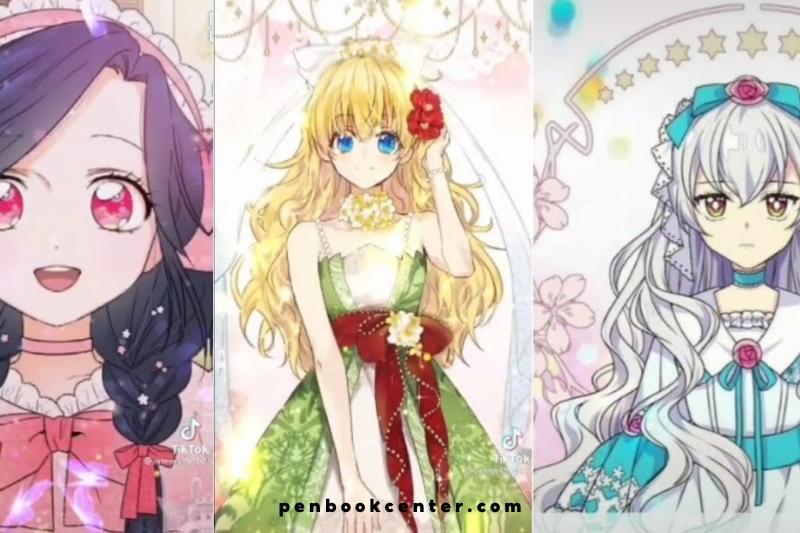
Cultural Content & Reading Direction
The content of an East Asian comic reflects its origin culture, and values. In the manga, there are numerous fantasy and supernatural stories about shinigami death gods, such as Bleach and Death Note. Manhwa often has storylines related to Korean beauty culture, like True Beauty. At the same time, manhua features many wuxia (martial arts chivalry) themed comics.
Although manhua has captivating storylines, it’s also been criticized for a foundational lack of a coherent narrative. However, this shouldn’t discourage you from giving manhua a try.
Manga and manhua are read from right to left and top to bottom. However, manhwa is similar to American and European comics. They’re read from left to right and from top to bottom. The layouts are read from top to bottom, allowing for infinite scrolling when it comes to digital comics.
The printed manga has limitations when depicting movement in the artwork; however, the vertical layout and infinite scrolling in digital manhwa and manhua are used to strategically depict the movement of objects descending or the passage of time.
The Artwork & Text
Manga is usually published in black and white in print and digital, unless they are special releases and printed in full color or with color pages. Digital manhwa is published in color, but print manhwa is traditionally published in black and white, similar to manga. Like manhwa, digital manhua is also published in color.
Inspired by the art of Walt Disney, Tezuka Osamu drew his characters with big eyes, small mouths, and exaggerated facial expressions to emphasize certain emotions. Tezuka’s art style influenced the artwork of other artists in Japan and elsewhere. However, manhwa and manhua characters are drawn to focus on more realistic human proportions and appearances.
Manga and manhwa also have realistic and detailed background settings, almost photo-realistic, in contrast to digital manhwa, which has simpler backgrounds though it should be noted that print manhwa is more similar to manga in this regard.
Manga also uses a unique set of onomatopoeia in their narratives to describe the sounds of animals and inanimate objects and the sounds of psychological states and emotions. These onomatopoeiae are written in a page’s surrounding panels and gutters, much like American comics.
Likewise, manhwa and manhua have their own set of onomatopoeia used to describe emotions and movements. Also, digital manhwa often uses music and soundbites to enhance the reading experience, something novel to their electronic presentation.
With the internet, we have easy access to many East Asian comics. Whether you are reading manga, manhwa or manhua, each comic has its merits, which only enhance the reading experience for anyone anywhere.
FAQs
Are Manhwas read left to right?
Yes, manhwas are read left to right. This is because they are originally written in Korean, which is read from left to right. So when they are translated into English, they are still read from left to right.
Which is more popular, manhwa or manga?
There’s no clear answer to which is more popular, manhwa or manga. Both have their own devoted fanbases, and it really depends on what you’re looking for in a story.
Manhwa tends to be more associated with Korean culture, while manga is more associated with Japanese culture. So if you’re looking for something with a more Korean flavor, manhwa might be the way to go. But if you’re just looking for a good story, either manhwa.
Why is manga black and white?
Manga is a Japanese comic book that is typically black and white. There are many reasons why manga is black and white, but the most common reason is that it is cheaper to print. Black and white manga can also be more visually appealing than the color manga.
Conclusion
Manhua, manga, and manhwa, in all its forms, will continue to grow in worldwide acclaim. And as they become more well-known, so will their clout. Webtoons now include digital comics from throughout the globe, as we’ve previously seen.
There are increasing numbers of North American publishers that plan on producing manga in the English language, such as World Piece. Both formats’ extensive availability and accessibility will impact any parallels or distinctions in the future.
Whether manga, manhwa, or manhua, an anime may appeal to you. What is your favorite and why? Please share your thoughts in the section below.
Read more:
- Best Graphic Novels VS Comic Books: What’s the difference? [2022]
- Top 28 Best Manga Like Solo Leveling To Read Reviews [2022]
- How To Read Manga? Best Full Guide 2024
- Top 50+ Best Comic Books Of All Time Review [2022]
- How Does Negan Die In The Walking Dead Comic Books? [2022]
